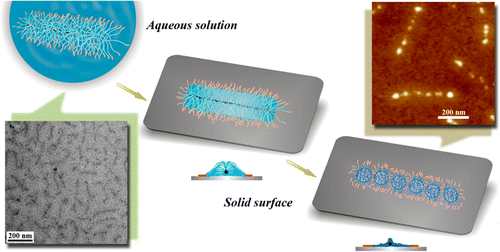Surface Interactions Surpass Carbon¨CCarbon Bond: Understanding and Control of the Scission Behavior of Core¨CShell Polymer Brushes on Surfaces |
| Time£º2013-04-07 16:04 |
Zhicheng Zheng , Markus Müllner , Jun Ling *, and Axel H. E. Müller * ACS Nano, 2013, 7 (3), pp 2284–2291 DOI: 10.1021/nn3054347
Abstract
A tapping-mode AFM investigation of core–shell cylindrical polymer brushes (CPBs) on mica shows that they can be ruptured upon spin-coating. Three different CPBs were synthesized, having a methacrylate backbone, carrying branches of poly[oligo(ethylene glycol)methacrylate] (POEGMA), POEGMA-block-poly[2-(dimethylamino)ethyl methacrylate] (POEGMA-b-PDMAEMA), and POEGMA-block-poly[2-(methacryloyloxy)ethyl trimethylammoniumiodide] (POEGMA-b-PMETAI). The polymer backbone of core–shell CPB with POEGMA-b-PDMAEMA or POEGMA-b-PMETAI branches is ruptured upon drying on a mica surface, while they are stable in aqueous solution. We propose that the scission behavior is induced by Coulomb interactions between PDMAEMA or PMETAI corona and the solid surface and that this interaction is stronger than one or more carbon–carbon single bonds. We control this scission behavior by tuning the surface interactions through switching the surface nature, varying pH, or adding multivalent counterions. Our study demonstrates that core–shell CPB serves as a template to directly compare the weak intermolecular forces with the strong carbon–carbon covalent bonds.
Keywords:
cylindrical polymer brushes; polyelectrolytes; surface charges;intermolecular attractions; surface interaction energy; carbon−carbon bond energy;scission behavior

|
Read£º6600
|
